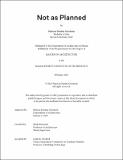Not as Planned
Author(s)
Dueñas Gerritsen, Patricia
DownloadThesis PDF (22.50Mb)
Advisor
Kennedy, Sheila
Terms of use
Metadata
Show full item recordAbstract
Architecture assumes too much. It assumes it can provide solutions that will always work. It assumes people will live in particular ways. It assumes buildings and conditions will last forever unaltered. These assumptions mean that buildings too often restrict change. The certainty of building has been taken for granted and as a result, buildings and their embodied materials are cast as collateral damage to new plans and new ideas. In place of this certainty, we need to accept that more often than not things do not go as planned.
The Providence Gas Company Purifier House serves as the physical and conceptual site for this thesis. It has undergone failure after failure—technological obsolesce, environmental disasters, economic collapse—making it both peculiar and paradigmatic. And while architecture does not have the agency to change these realities, it can respond. By considering a series of architectural propositions instead of a singular custom-fit design, this thesis asks: Can we think through multiple states and their transitions? What might this mean for sites of architecture and existing modes of practice?
To design differently, architects need to be more unsure and unassuming. Resigning control of future events means abandoning overdesigned and overdetermined systems of the past. This thesis presents a methodology of contingency plans that explores loose-fits and odd adjacencies resulting from existing forms. An embrace of nonlinear design has the potential to challenge standards, conventional programming, unproductive preservationist ideals, developer-driven notions of efficiency, and uncompromising aesthetic agendas.
Presuming that future plans will fail, yet still maintaining hope in them is a call to think through precarity. This means that architects must anticipate that their work will be rewritten, edited, and converted. An expanded notion of practice could also enable new tools of documentation, deconstruction, and maintenance. This thesis reimagines the architect as caretaker and argues for an architecture of revision and repair through the design of multiple futures.
Date issued
2023-02Department
Massachusetts Institute of Technology. Department of ArchitecturePublisher
Massachusetts Institute of Technology